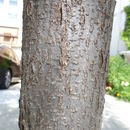More info for the terms:
natural,
treehoneylocust
common honeylocust
honey shucks locust
sweet bean locust
TAXONOMY:
The currently accepted scientific name for honeylocust is Gleditsia
triacanthos L. (Cesalpiniaceae) [
11,
14,
16,
27,
42]. Thornless
honeylocust (G. t. forma inermis Schneid.) is occasionally found wild
[
27,
42].
Natural hybridization between honeylocust and water-locust (G.
aquatica) has been reported [
27].
LIFE FORM:
Tree
FEDERAL LEGAL STATUS:
No special status
OTHER STATUS:
NO-ENTRY
DISTRIBUTION AND OCCURRENCE
SPECIES: Gleditsia triacanthos
GENERAL DISTRIBUTION:
The natural range of honeylocust extends from central Pennsylvania
through extreme southern Ontario, extreme southern Michigan, southern
Wisconsin, and extreme southeastern Minnesota to extreme southeastern
South Dakota; south through eastern Nebraska to eastern Texas; east to
Alabama; and northeast along the western slopes of the Appalachians.
Isolated populations occur in northwestern Florida. Honeylocust is
naturalized east of the Appalachians as far north as Nova Scotia [
16,
27].

